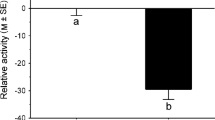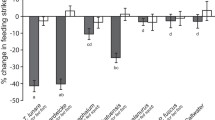Abstract
We stocked 39 juvenile pike, Esox lucius, into a previously pike free pond which contained a population of approximately 78 000 fathead minnows, Pimephales promelas. Fathead minnows sampled prior to pike stocking did not show a stereotypic fright response to either visual or chemical cues from pike. After stocking pike, we sampled minnows every two days for a period of two weeks. Minnows sampled six days after stocking still did not show a fright response to the sight of a pike, but those sampled eight days after stocking did exhibit a significant fright response, indicating that acquired predator recognition based on vision occurred between six and eight days. Minnows sampled two days after stocking did not show a fright response to chemical cues of a pike. Those sampled four days after did, however, exhibit a significant fright response, indicating that acquired predator recognition based on chemical cues occurred between two and four days. These data indicate that acquired predator recognition occurs very rapidly and that the rate of learning of predator identity differs for chemical versus visual cues.
Similar content being viewed by others
References cited
Brown, G.E. & R.J.F. Smith. 1994. Fathead minnows use chemical cues to discriminate shoalmates from unfamiliar conspecifics. J. Chem. Ecol. 20: 3051–3061.
Brown, G.E., D.P. Chivers & R.J.F. Smith. 1995a. Fathead minnows avoid conspecific and heterospecific alarm pheromones in the faeces of northern pike. J. Fish Biol. 47: 387–393.
Brown, G.E., D.P. Chivers & R.J.F. Smith. 1995b. Localized defecation by pike (Esox lucius): a response to labelling by cyprinid alarm pheromone? Behav. Ecol. Sociobiol. 36: 105–110.
Chivers, D.P. & R.J.F. Smith. 1994a. Fathead minnows (Pimephales promelas) acquire predator recognition when alarm substance is associated with the sight of unfamiliar fish. Anim. Behav. 48: 597–605.
Chivers, D.P. & R.J.F. Smith. 1994b. The role of experience and chemical alarm signaling in predator recognition by fathead minnows, Pimephales promelas. J. Fish Biol. 44: 273–285.
Chivers, D.P. & R.J.F. Smith. 1995a. Fathead minnows (Pimephales promelas) learn to recognize chemical stimuli from high risk habitats by the presence of alarm substance. Behav. Ecol. 6: 155–158.
Chivers, D.P. & R.J.F. Smith. 1995b. Free-living fathead minnows (Pimephales promelas) rapidly learn to recognize pike (Esox lucius) as predators. J. Fish Biol. 46: 949–954.
Chivers, D.P. & R.J.F. Smith. 1995c. Chemical recognition of risky habitats is culturally transmitted among fathead minnows, Pimephales promelas (Osteichthyes, Cyprinidae). Ethnology 99: 286–296.
Chivers, D.P., G.E. Brown & R.J.F. Smith. 1995. Acquired recognition of chemical stimuli from pike, Esox lucius, by brook sticklebacks, Culaea inconstans (Osteichthyes, Gasterosteidae). Ethology 99: 234–242.
Chivers, D.P., G.E. Brown & R.J.F. Smith. 1996. The evolution of chemical signals: attracting predators benefits alarm signal senders. Amer. Nat. (in press).
Cole, K.S. & R.J.F. Smith. 1987. Release of chemicals by prostaglandin-treated female fathead minnows, Pimephales promelas, that stimulate male courtship. Hormone Behav. 21: 440–456.
Cole, K.S. & R.J.F. Smith. 1992. Attraction of female fathead minnows, Pimephales promelas, to chemical stimuli from breeding males. J. Chem. Ecol. 18: 1269–1284.
Curio, E. 1988. Cultural transmission of enemy recognition in birds. pp. 75–98. In: T.R. Zentall & B.G. Galef, Jr. (ed.) Social Learning: Psychological and Biological perspectives, Lawrence Erlbaum, Hillsdale.
Heczko, E. & B.H. Seghers. 1981. Effects of alarm substance on schooling in the common shiner (Notropis cornutus, Cyprinidae). Env. Biol. Fish. 6: 25–29.
Högstedt, G. 1983. Adaptation unto death: function of fear screams. Amer. Nat. 121: 562–570.
Krause, J. 1993. The effect of "schreckstoff on the shoaling behaviour of the minnow: a test of Hamilton's selfish herd theory. Anim. Behav. 45: 1019–1024.
Lawrence, B.J. & R.J.F. Smith. 1989. Behavioral responses of solitary fathead minnows, Pimephales promelas, to alarm substance. J. Chem. Ecol. 15: 209–219.
Mainardi, D. 1980. Tradition and the social transmission of behaviour in animals. pp. 227–255. In: G.W. Barlow & J. Silverberg (ed.) Sociobiology: Beyond Nature/Nature? AAAS Selected Sympos. 35, Westview Press, Boulder.
Mathis, A. & R.J.F. Smith. 1993a. Fathead minnows, Pimephales promelas, learn to recognize northern pike, Esox lucius, as predators on the basis of chemical stimuli from minnows in the pike's diet. Anim. Behav. 46: 645–656.
Mathis, A. & R.J.F. Smith. 1993b. Chemical labeling of northern pike (Esox lucius) by the alarm pheromone of fathead minnows (Pimephales promelas). J. Chem. Ecol. 19: 1967–1979.
Mathis, A. & R.J.F. Smith. 1993c. Intraspecific and cross-superorder response to chemical alarm signals by brook sticklebacks. Ecology 74: 2395–2404.
Mathis, A. & R.J.F. Smith. 1993d. Chemical alarm signals increase the survival time of fathead minnows (Pimephales promelas) during encounters with northern pike (Esox lucius). Behav. Ecol. 4: 260–265.
Mathis, A., D.P. Chivers & R.J.F. Smith. 1993. Population differences in responses of fathead minnows (Pimephales promelas) to visual and chemical stimuli from predators. Ethology 93: 31–40.
Mathis, A., D.P. Chivers & R.J.F. Smith. 1995. Chemical alarm signals: predator-deterrents or predator attractants? Amer. Nat. 146: 994–1005.
Mathis, A., D.P. Chivers & R.J.F. Smith. 1996. Cultural transmission of predator recognition in fishes: intraspecific and interspecific learning. Anim. Behav. 51: 185–201.
Mineka, S. & M. Cook. 1988. Social learning and the acquisition of snake fear in monkeys. pp. 51–74. In: T.R. Zentall & B.G. Galef, Jr. (ed.) Social Learning: Psychological and Biological Perspectives, Lawrence Erlbaum, Hillsdale.
Pitcher, T.J. 1980. Some ecological consequences of fish school volumes. Freshwater Biol. 10: 539–544.
Pitcher, T.J. & J.K. Parrish. 1993. Functions of shoaling behaviour in teleosts. pp. 363–439. In: T.J. Pitcher (ed.) Behaviour of Teleost Fishes, 2nd ed., Chapman and Hall, London.
Siegel, S. 1956. Nonparametric statistics for the behavioral sciences. McGraw-Hill, New York. 312 pp.
Sherman, P.W. 1977. Nepotism and the evolution of alarm calls. Science 197: 1246–1253.
Smith, R.J.F. 1973. Testosterone eliminates alarm substance in male fathead minnows. Can. J. Zool. 51: 875–876.
Smith, R.J.F. 1986a. The evolution of chemical alarm signals in fishes. pp. 99–115. In: D. Duvall, D. Müller-Schwarze & R.M. Silverstein (ed.) Chemical Signals in Vertebrates, Vol. 4, Plenum Press, New York.
Smith, R.J.F. 1986b. Evolution of alarm signals: role of benefits derived from retaining group members or territorial neighbors. Amer. Nat. 128: 604–610.
Smith, R.J.F. 1992. Alarm signals in fishes. Rev. Fish Biol. Fish. 2: 33–63.
Smith, R.J.F., B.J. Lawrence & M.J. Smith. 1991. Cross-reactions to skin extract between two gobies, Asterropteryx semipunctatus and Brachygobius sabanus. J. Chem. Ecol. 17: 2253–2259.
Smith, R.J.F. & M.J. Smith. 1989. Predator-recognition in two species of Gobiid fishes, Asterropteryx semipunctatus and Gnatholepis anjerensis. Ethology 83: 19–30.
Smith, R.L. 1980. Ecology and field biology, 2nd ed. Harper and Row, New York. 686 pp.
Trautman, M.B. 1981. The fishes of Ohio, 2nd ed. Ohio State University Press, Columbus. 782 pp.
Verheijen, F.J. 1956. Transmission of a fright reaction amongst a school of fish and the underlying sensory mechanisms. Experientia 12: 202–204.
Wisenden, B.D., D.P. Chivers, G.E. Brown & R.J.F. Smith. 1995. The role of experience in risk assessment: avoidance of areas chemically labeled with fathead minnow alarm pheromone by conspecifics and heterospecifics. Écoscience 2: 116–122.
Author information
Authors and Affiliations
Rights and permissions
About this article
Cite this article
Brown, G.E., Chivers, D.P. & Smith, R.J.F. Differential learning rates of chemical versus visual cues of a northern pike by fathead minnows in a natural habitat. Environmental Biology of Fishes 49, 89–96 (1997). https://doi.org/10.1023/A:1007302614292
Issue Date:
DOI: https://doi.org/10.1023/A:1007302614292




